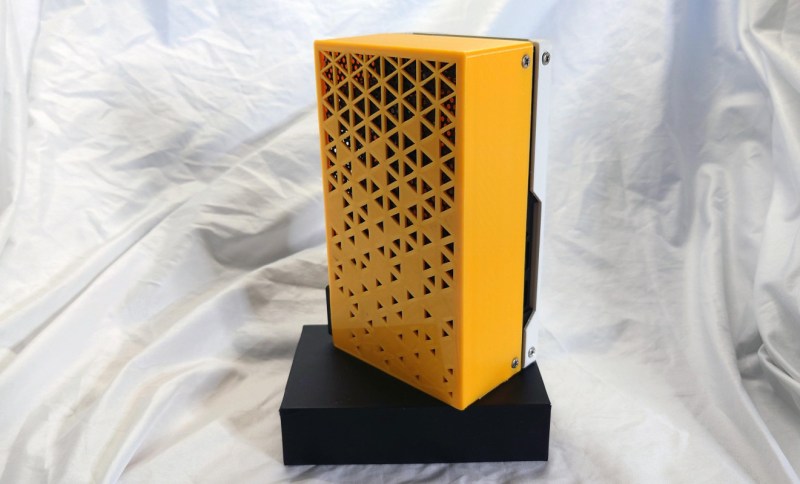Since the widespread adoption of USB 1.1 in the 90s, USB has become the de facto standard for connecting most peripherals to our everyday computers. The latest revision of the technology has been USB 4, which pushes the data rate capabilities to 40 Gbit/s. This amount of throughput is mindblowing compared to the USB 1.x speeds which were three to four orders of magnitude slower in comparison. But data speeds haven’t been the only thing changing with the USB specifications. The amount of power handling they can do has increased by orders of magnitude as well, as this DIY USB charger demonstrates by delivering around 200 W to multiple devices at once.
The build comes to us from [tobychui] who not only needed USB rapid charging for his devices while on-the-go but also wanted to build the rapid charger himself and for the charger to come in a small form factor while still using silicon components instead of more modern gallium nitride solutions. The solution he came up with was to use a 24 V DC power supply coupled with two regulator modules meant for solar panel installations to deliver a staggering amount of power to several devices at once. The charger is still relatively small, and cost around $30 US dollars to make.
Part of what makes builds like this possible is the USB Power Delivery (PD) standard, which has enabled all kinds of electronics to switch to USB for their power needs rather than getting their power from dedicated, proprietary, and/or low-quality power bricks or wall warts. In fact, you can even use this technology to do things like charge lithium batteries.

















Audio is unintelligible !
Turning on CC helps.
This link is critical I think but I can’t make sense of it, all Chinese:
2 × 65W / 100W Solar PD Regulator Module (Vmax = 32V)
https://item.taobao.com/item.htm?spm=a1z09.2.0.0.38862e8dOCca3A&id=684086754983&_u=b1t392v5954f
I’ve translate some spec from your link
Input Voltage 12v to 30v
Support USB-A quick charge protocol (blahblah) and USB Type-C quick charge protocol (blahblah)
The USB Type-C support PD 3.0
USB Type-C would auto detect, when detect EMARK cable, support 20v/5A 100W at maximum
it has 3 model 45w/65w/100w
But I think the key should be that 24v 9A adapter, the AC adapter is smaller than I thought
It seems like this one
https://detail.tmall.com/item.htm?spm=a230r.1.14.16.52d54093aUr2in&id=608881587491&ns=1&abbucket=13&skuId=4913423192611
Hmmm… the adapter over 200w… for safety, I’ll prefer to pick a normal adapter with lot cert
@mosquito520 said: “I’ve translate some spec from your link”
@mosquito520, thank you for your help. You are lucky to have command of both languages.
no digital information? sorry not for me
Everyone else manages just fine
I have to put taobao addresses into superbuy to be able to read them.
Interesting, wish it wasn’t so hard to get some stuff.
Darnit, now I’ve gone and ordered the 100w 65w and 45w ones. Came out to $16, will have to pay seperate shipping/handling.
Wish I knew what the text in the picture was saying. Hopeful it will work to transform cheap 18v drill packs into Steamdeck/laptop chargers.
Now I gotta find a link for the m.2 WWAN slot to 4x USB hub PCB with space for internal logitech unifying receiver.
What is the DC port on those modules, is it just connected to the input, or is it regulated to 24v, 12v, etc?
Looking at the Circuit board it is direct connected on ground. The Center pin goes through a diode from the input solder pads.
I’m not sure which way the Diode is, maybe the DC jack is power out only. I’m going by the fact the diode is marked D4 and it only has in and out to the package. The jack is on the tab side of the component package, 2 legs are going to the positive solder input.
This would be much more useful if it had some batteries.
Actually, I thought such a thing might exist, a GaN wall charger, with built-in battery power bank, and comprehensive USB PD outputs.
But it must be quite rare, and I can’t find one.
That would make a great DIY project; GaN (compact) AC/DC converter to BMS, a bank of 18650 or 21700 batteries (maybe 6S to give 20V), then powering the USB PD modules used here.
Anker sells something like this. Quite expensive though. If you search “Anker 733 Power Bank” you should find it.
Agree, interested how it does buck/boost when voltage gets near 20v. I’ve got 3 Nissan leaf 2s packs, would make a killer power bank. Or Hyundai 8s pack would work too.
Why is the article tagged with gallium nitride and GaN when it explicitly doesn’t contain those elements?
If you just need the USB PD in 65w I have found a very cheap adapter ($8 with shipping to USA, 2 for $12)
aliexpress item/3256801379539943
Looking into the circuit board, the chip is an IP6518 PD and buck convertor, I might be able to attach it to 6S battery pack for charging a laptop. Maybe a 5S pack for EG Steamdeck (15v 3A). 3s or 4s pack for 5v-9v phones.
Now I have IP2368 to look into as well, it says bidirectional, not sure why or how, investigation commences!